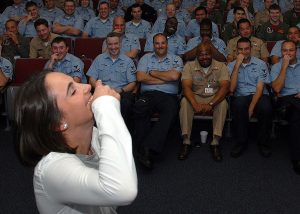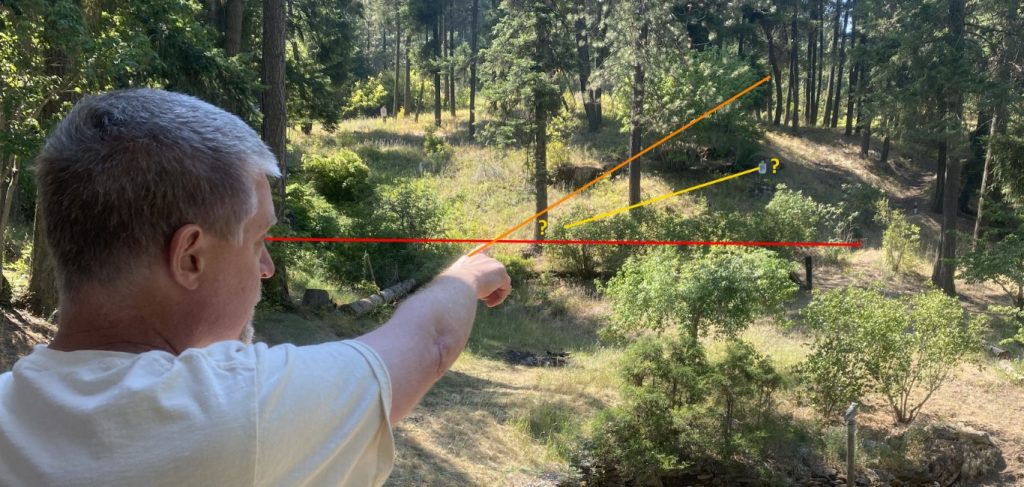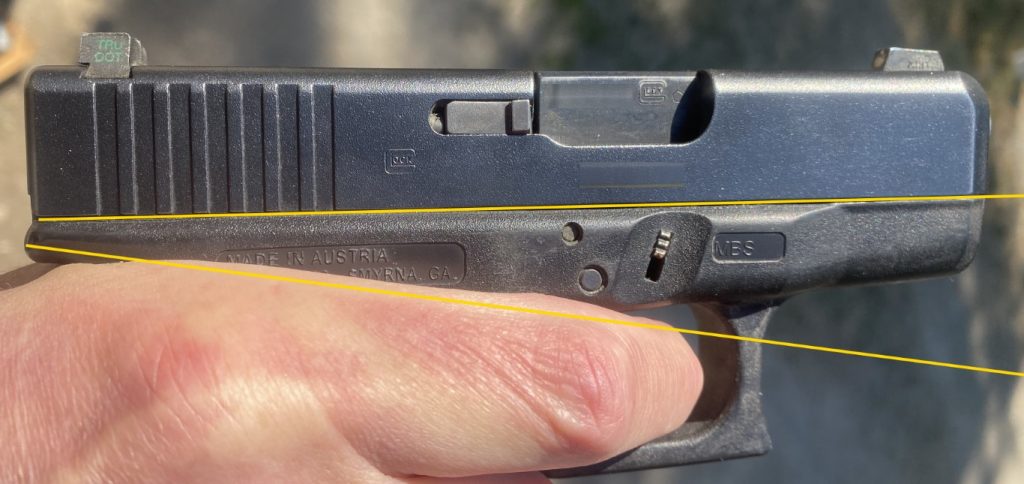There is a myth in shooting that people have been “pointing since they were babies” so they can point a gun and hit what they want to hit.
The two statements “people have been pointing since babies” and “people can point shoot accurately” are both true, but they have no relation to each other.
Pointing accurately can be trained, but naturally accurate pointing…let alone naturally accurate point shooting…is a myth.
Accurate pointing is not true with touch screens, with shooting, or even men trying to hit urinals/toilets
With the advent of touch screens and gesture activated smart appliances, we now have studies to tell us just how accurate we are at pointing and how to improve it.
One 2009 study out of Australia, “Hand Pointing Accuracy for Vision-Based Interactive Systems” found that pointing inaccuracies could be as much as 9.5″ at 10 feet! That’s a miss on a head and could easily be the difference between an effective hit and an ineffective hit on the chest.
Even if you are SOMETIMES an accurate pointer, that doesn’t mean you always will be.
Ever hear of a field sobriety test? Where the challenge is to touch your own nose? This is way easier than accurately pointing at something not attached to your face.

Our ability to point accurately drops off pretty quickly for some people with alcohol. But also with fatigue from sleep and fatigue from exertion. Age has a negative effect, warming up has a positive effect, hunger and blood sugar negatively impacts it, accuracy drops as movement speed increases, and concussions and TBIs usually cause a drop in pointing accuracy.
The speed factor is important. People are MUCH more accurate with pointing if they’re moving slow enough to correct movement based on what they see. That feedback/correction loop takes about .10-.20 seconds, which is way too long for point shooting and, if you need it, you’re probably better off using your sights.
One of the crazy findings is that a big factor in the ability to point accurately is whether or not you can see both your hand and the target before you start moving…which may happen in day-to-day pointing, but not for drawing, presenting, and shooting.
What IS pointing?
THIS is interesting.
When most people point precisely, they are lining up the tip of their finger slightly below the line connecting their dominant eye and the target. (red line below)
If you run a laser through their finger and extend it out, it would miss the target that they’re “pointing” at. (orange line below)
Here’s an illustration:

From my perspective, I’m pointing down the red line, at an orange target.
But when you look directly down my arm and along my finger, I’m pointing along the orange line…way off from what I THINK I’m aiming at.
To add even more complexity, from the perspective of the camera, it looks like I’m pointing at the white target.
How we define pointing becomes an issue with aiming a pistol as well.

Are we concerned about pointing the muzzle or pointing our finger?
Since most defenders of point shooting claim that you can hit what you want point shooting because you’ve been pointing since birth, I’m going to go out on a limb and claim that the belief is that the finger and muzzle are both pointing at the same target at the same time.
When my grip is high on the backstrap and my finger is in the trigger guard, it is not parallel to the muzzle…so the muzzle won’t be aiming at anything that I’m “naturally” pointing at.
The case against point shooting as an inborn, instinctive ABILITY (vs. skill) gets worse…
Because even if you get accurate pointing figured out and apply it to the muzzle, CONSISTENT accurate pointing with a pistol depends on a consistent grip and there is nothing inborn about that. It’s a SKILL that has to be practiced on a regular basis.
Does that mean point shooting doesn’t work or can’t work?
NO! Absolutely not.
It means that point shooting as an ABILITY you’re born with is a myth. But point shooting or unsighted shooting IS a skill that can and should be developed.
Like any skill, there are hard ways and easy ways to do it…right ways and wrong ways.
Most people learn point shooting in isolation through high repetition, brute force training.
A better approach is to practice your sighted shooting in a way that simultaneously gives you point shooting skills…and red dot skills…and skills that carry over to carbine.
And, at the same time, do drills that improve hand-eye coordination…so you can slash the number of rounds or reps that it takes to build the skill AND improve your cold (not warmed up) performance.
Improving hand-eye coordination delivers the sights between your dominant eye and the target quicker and more accurately, regardless of whether you’re doing sighted or point shooting.
I’ve got a presentation on it that you may want to watch at https://VisionTraining.com
It covers several misunderstandings about eye dominance, visual confusion, both eyes open shooting, and hand-eye coordination for shooting.
-Ox
“Don’t Just Train Hard…Train Smarter Than The Other Guy”
“Hand Pointing Accuracy for Vision-Based Interactive Systems” https://link.springer.com/chapter/10.1007%2F978-3-642-03658-3_4
“Biomechanics of Pointing to a Perceived Target: Effects of Fatigue and Gender” https://link.springer.com/chapter/10.1007/978-3-642-21683-1_59
“Factors Influencing Proprioception” https://www.intechopen.com/chapters/19663
8 Comments
rod vanzeller
July 17, 2023By the way, when you to Peyton gun adrenal stress class did you use the sites on the scenarios?
Ox
July 29, 2023I haven’t done Peyton’s class, but I’m a Reality Based Training Association Master Instructor and used to run classes with a stress shooting lab in Minneapolis. I have had scenarios where I’ve transitioned from shooting close-in threats without sights to using a crisp sight picture to shoot a threat with partial exposure further away while my chest-strap heartrate monitor was showing 170+ bpm.
Roderick Van Zeller
October 20, 2023Finally found your answer, thank you.
rod vanzeller
July 16, 2023Try this and see what happens, grab a 1911 use the middle finger on the trigger and the index along the frame pointing at the target.
Let me know what happens.
Ox
July 16, 2023That is one part of the equation and a fun drill for how to run a gun if your trigger finger gets injured, but the point of the article is that there is no connection between what we call “pointing” and what we do for shooting.
When we point, we have knuckles up. When we shoot, we have knuckles to the side.
When we point, we align the tip of our finger just under the line connecting our dominant eye and what we’re pointing at. When we shoot, we align the muzzle with the line between our dominant eye and the target.
When we point, we do so slow enough that we can correct the trajectory of our aim as we’re extending our finger. When we shoot, if our sights are not automatically aligned, we introduce lag, frustration, and variability and we generally need to extend our hand/sights faster than what our visual system can correct.
When we point, we do it slow enough that we don’t need our senses to be integrated. When we shoot, our issues, challenges, and frustrations grow exponentially when we don’t have our senses integrated.
What have you found when you’ve done middle finger shooting with a 1911? 🙂
rod vanzeller
July 16, 2023I am so used to point shooting that it did not make any difference.
I think it is funny how you mentioned we point with knuckles up, gangbangers perp shoot knuckles up and hit everything except the intended target lol.
When I train accessing the weapon on the ground kicking the assailant sideways I shoot the laser trainer knuckles up and get good hits, but we are talking extreme close distances.
I dry fire every day at moving targets with laser trainers, I have styrofoam heads hanging on fishing line in my house. Live fire at the range once or twice a week.
Also, for home training I modified safety glasses so that there is no perifereal vision, this trains “Watch the crosswalks and the stairs”.
Have you modified safety glasses as a training aid to simulate tunnel vision?
Also at the range, I use 5 different platforms of make and caliber in between for versatility,my grip is universal for transitioning from semi auto to revolver double single action.
Yes, I take my training very seriously.
Ox
October 20, 2023Hey Rod, you made a couple of great points…
1. “I am so used to point shooting”
2. “I dry fire every day at moving targets”
There are 2 ways that people can be accurate with “point” shooting and that is frequent high volume repetition and sensory integration.
There are a few big things that can negatively impact both groups:
1. Hits to the head before you need to aim and shoot…either from strikes, falling, or running into something.
2. Concussive forces like pressure waves.
3. Illness that impacts sensory integration like Covid
4. 300+ prescription medications that negatively impact sensory integration
Unless you’re the aggressor and get to choose the time and place of a conflict, you don’t know whether one or more of those factors will be in play. If they are, it’s unlikely that you’ll have the same performance that you normally do.
That is why I teach an approach that integrates point shooting and sighted shooting. Not because I don’t like either of them, but because they both have gaps that are filled by the other.
Keep training hard & smart.
rod vanzeller
February 10, 2024Here is an example of one of my drills to address some of the issues you mention.
Physical exertion, spin with eyes closed,
training partners strike with shields, draw and point shoot train under that simulated stress. Nothing mimics the real thing, this type of training does give a better survival chance.
Leave A Response